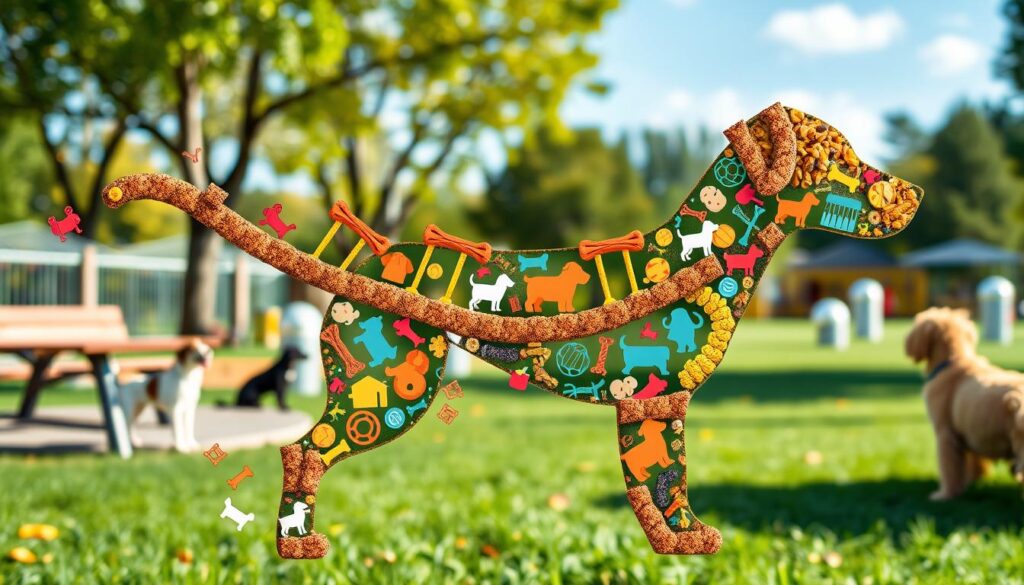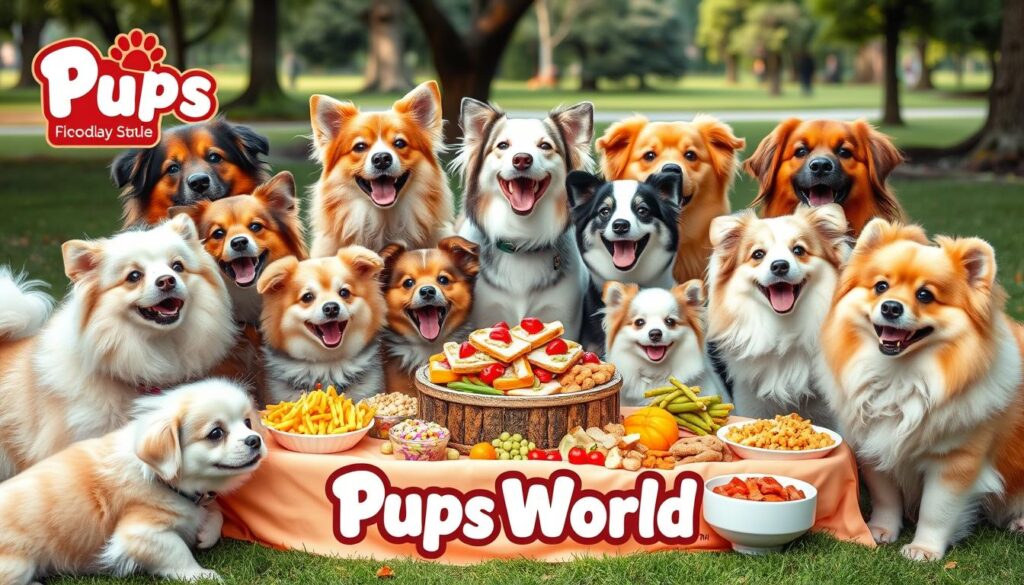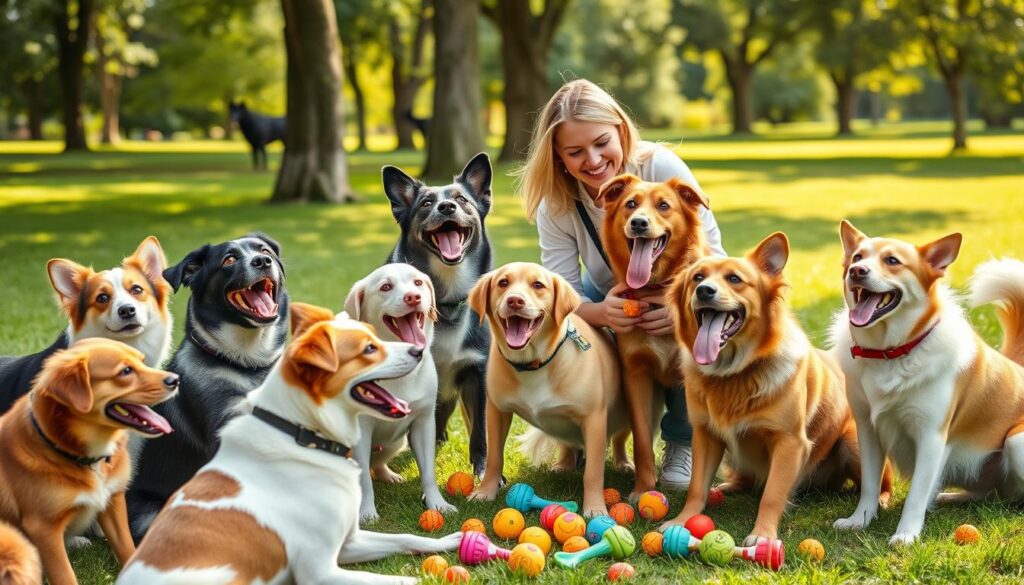Discover which canine companions top the list as the 11 Most Food Obsessed Dog Breeds and learn about their feeding habits and diet preferences. Ever seen a dog always wanting more food? Some dogs just can’t get enough to eat. This article looks at the 11 most food-obsessed dog breeds. We’ll see how their love for food affects their training and health.
Knowing about these breeds and their eating habits helps you take better care of your dog. It makes sure your dog stays healthy and happy.
Key Takeaways
- Some dog breeds are naturally more motivated by food than others.
- Understanding food obsession can enhance your training approach.
- The environment plays a crucial role in a dog’s feeding habits.
- Health implications can arise from overfeeding food obsessed breeds.
- Recognizing hunger cues is vital for maintaining your dog’s health.
Table of Contents
Understanding Food Obsession in Dogs
Dogs can become obsessed with food, showing behaviors like eating a lot and always looking for food. This can come from how they were raised, their environment, and past experiences. It’s important for owners to understand why their dogs act this way.
How a dog acts shows its personality and how it reacts to its world. Dogs that didn’t always have enough food might eat a lot. Dogs that are curious or anxious might eat more because of these feelings.
Food obsession can lead to health problems, like being overweight. This can cause issues like joint pain, diabetes, and heart disease. Knowing when a dog is obsessed with food helps owners find the right way to feed them.
| Behavioral Traits | Potential Causes | Health Risks |
|---|---|---|
| Voracious Eating | Scarcity of food in early life | Obesity, Joint problems |
| Scavenging | Lack of supervision | Gastrointestinal issues, Diabetes |
| Stealing Food | Engagement in competitive feeding | Heart disease, Behavioral disorders |
The Role of Genetics in Food Motivation
Understanding genetics in dogs helps us see why some breeds love food so much. Some breeds were made for hunting and foraging. This is true for Labradors and Beagles, bred for their work skills. These skills make them want to find food.
Food-loving breeds act like they used to in the wild. For example, Labradors were made to bring back game for hunters. They got food as a reward. Herding breeds are full of energy and need lots of food because they’re always moving.
This history affects their eating habits and how much they love food. It’s important to know this when thinking about pet nutrition. If not watched, these dogs might get too fat or have health problems. Knowing about their nature and feeding them right is key to their health.

| Breed | Genetic Background | Food Motivation Level | Common Health Risks |
|---|---|---|---|
| Labrador Retriever | Retrieving | High | Obesity, Hip Dysplasia |
| Beagle | Hunting | High | Obesity, Ear Infections |
| Border Collie | Herding | Moderate | Hip Dysplasia, Seizures |
| Dachshund | Hunting | Moderate | Obesity, Intervertebral Disc Disease |
Top Characteristics of Food Obsessed Dog Breeds
Food obsessed dog breeds show many characteristics that show their love for food. These traits change how they act with their owners and the world around them.
- Eager Attitude: These breeds get really excited at meal times. They might jump or bark with joy.
- Tendency to Beg: They love to beg for food. Sometimes, they even steal food if they can.
- Motivation Levels: Food makes them very motivated. It’s a great way to get them to listen in training.
- Destructive Behaviors: Without food, they might chew on things or bark a lot. They just want food.
Studies show that these dog behaviors can affect their health. Eating too much can make them overweight and lead to health problems. So, it’s key to know these traits to take care of a food obsessed dog.
| Characteristic | Description |
|---|---|
| Eager Attitude | Shows a lot of excitement at meal times, often jumping or barking. |
| Tendency to Beg | Always begs for food and might steal it if it’s left out. |
| Motivation Levels | Very motivated by food in training; treats work well as rewards. |
| Destructive Behaviors | May chew or bark a lot when wanting food, especially if it’s not allowed. |

11 Most Food Obsessed Dog Breeds
Some dog breeds love food more than others. This makes them behave in certain ways. Let’s look at four breeds that really love food:
Breed 1: Labrador Retriever
The Labrador Retriever is at the top for food obsession. They are friendly and love food a lot. This can lead to weight issues if not managed well.
They are great at begging for food. So, it’s important to watch what they eat to keep them healthy.
Breed 2: Beagle
Beagles have a strong sense of smell that makes them search for food. They can be very persistent when they find food. Owners often see them go to great lengths for a snack.
Because they are small, it’s important to control their food portions. This helps prevent health problems.
Breed 3: Dachshund
Dachshunds are playful and love food a lot. Their hunting background makes them chase snacks. They might eat too much, so owners need to watch their diet.
Breed 4: Golden Retriever
Golden Retrievers are loyal and smart, and they love food. They get excited at meal times. They might beg or steal food, showing how much they love it.
It’s important to give them a balanced diet and limit treats. This helps keep their weight in check.

Feeding Habits of Food Obsessed Breeds
Managing the feeding habits of food obsessed dog breeds needs a careful approach. Owners must balance giving enough nutrition and stopping overeating. It’s key to use proper portion control tips and understand hunger cues for a healthy dog diet.
Portion Control Tips
Effective portion control is key for a food-obsessed dog. Here are some tips:
- Calculate daily caloric needs based on your dog’s weight, activity level, and age.
- Divide the daily food amount into two or three controlled portions.
- Use measuring cups to ensure accuracy in serving sizes.
- Avoid free-feeding; instead, establish set meal times to create a routine.
- Be consistent with food types and avoid frequent changes in the dog’s diet.
Understanding Hunger Cues
Understanding hunger cues correctly can stop overfeeding. Here are signs to watch for:
- Pawing at the food container may show hunger.
- Following you around during meal prep can mean they’re waiting for food.
- Vocalizations might signal hunger, but they can also be learned habits.
- Watch how the dog acts; if they don’t seem interested in food, they might be full.
By focusing on these habits, using portion control tips, and watching for hunger cues, owners can help their pets stay healthy and happy.
| Hunger Cue | Possible Interpretation | Recommended Action |
|---|---|---|
| Pawing at the food container | Indicates hunger | Serve pre-measured portion |
| Following during meal prep | Anticipation for food | Stick to scheduled feeding times |
| Vocalizations | Learned behavior more than hunger | Assess time since last meal |
| Lack of enthusiasm | Possible overeating or boredom | Evaluate meal quality and quantity |
Training Food Motivated Breeds Effectively
Training food motivated breeds needs a deep understanding of their love for treats. Tailoring training for these breeds gets the best results. Using treats makes them pay attention and learn good behaviors. Positive reinforcement makes learning fun and strengthens the bond with the owner.
Using Treats in Training
Using treats wisely can motivate food-loving dogs. It’s important to pick the right treat. Think about these things:
- Size: Small treats are good for giving many rewards without making them too full.
- Flavor: Choose treats they love to make them more excited.
- Texture: Some dogs like soft, chewy treats better.
Try different treats to see what your dog likes best. Watch how they react to help improve your training.
Positive Reinforcement Techniques
Positive reinforcement makes training food motivated breeds work better. This method rewards good actions, not bad ones. Here are some ways to do it:
- Give treats right after they do what you want.
- Use praise with treats to make good actions even better.
- Slowly stop using treats for commands they know well, but keep praising them.
These methods create a positive learning space. Both the dog and the trainer enjoy it. Using healthy treats keeps training balanced and good for their health.

Nutrition Considerations for Hungry Hounds
It’s key to know what food-obsessed dog breeds need to stay healthy. A diet made just for them can stop many diet problems. This makes their life better. The right diet should match their high energy and tendency to eat too much.
Best Diet for Food Obsessed Breeds
For food obsessed breeds, pick foods rich in protein and fiber. Choose high-quality dog food that fits their active lifestyle. This helps them get enough nutrition and avoid gaining too much weight. Here are some good things to add:
- Lean meats: Chicken, turkey, and fish give protein without too much fat.
- Whole grains: Brown rice and oats give energy and help with digestion.
- Vegetables: Carrots and green beans add fiber and important nutrients.
- Healthy fats: Omega-3 and Omega-6 fatty acids keep skin and coat healthy.
Always talk to a vet to make sure the dog food you pick fits your pup’s health needs.
Common Dietary Issues to Watch Out For
Food obsessed breeds often face diet problems that can hurt their health. It’s important to know about these issues to act fast:
- Obesity: Too much weight can cause joint problems and shorten their life.
- Food allergies: Some dogs might get allergies to certain foods, causing discomfort and health problems.
- Digestive issues: Bad food choices can lead to diarrhea or vomiting.
Regular vet check-ups can spot diet problems early and offer solutions just for them.

| Dietary Component | Benefits |
|---|---|
| Lean Meats | High in protein, aids in muscle maintenance. |
| Whole Grains | Provides slow-releasing energy and supports digestive health. |
| Vegetables | Offers vitamins and minerals essential for overall health. |
| Healthy Fats | Promotes skin and coat health, aids in nutrient absorption. |
Fun Activities for Food Lovers
Food-obsessed dogs need fun and engaging activities. These activities mix their love for food with play. They help keep dogs happy and healthy. Interactive feeding toys make mealtime fun and challenging.
Interactive Feeding Toys
Interactive feeding toys slow down your dog’s eating and keep them thinking. They come in many designs. Dogs have to work to get their food or treats out. Here are some great options:
- KONG Classic Dog Toy – Stuff it with peanut butter or kibble for hours of entertainment.
- Outward Hound Hide-A-Squirrel Puzzle Toy – A fun game of hide and seek with plush toys.
- PetSafe Busy Buddy Bob-A-Lot – Adjustable openings that allow for different food sizes.
Homemade Treat Recipes
Homemade treats let you tailor your dog’s snacks to their tastes and needs. Here are three easy recipes to try:
- Peanut Butter and Banana Treats: Mix 1 ripe banana, 1 cup of peanut butter, and 2 cups of whole wheat flour. Roll into small balls and bake at 350°F for 15 minutes.
- Sweet Potato Chews: Slice a sweet potato into thin rounds, bake at 250°F for two hours, turning halfway. These chews are healthy and satisfying.
- Pumpkin Oatmeal Bites: Combine 1 cup of pumpkin puree, 1 cup of oats, and 1 egg. Shape into small cookies and bake at 350°F for 20 minutes.
These activities keep dogs happy and strengthen your bond. They make feeding time fun and exciting for your furry friend.
| Toy Type | Benefits | Recommended For |
|---|---|---|
| KONG Classic | Durable, can be stuffed with treats | Moderate to heavy chewers |
| Outward Hound Hide-A-Squirrel | Puzzles encourage problem-solving | All breeds |
| PetSafe Busy Buddy Bob-A-Lot | Adjustable difficulty level | Active dogs |
Conclusion
Knowing about food obsessed dog breeds is key for pet owners. Breeds like the Labrador Retriever and Beagle love food a lot. Understanding their food habits can make your bond stronger and improve your life together.
Training tips like positive reinforcement and treats can help. Also, giving them the right amount of food and a balanced diet is important. This helps avoid health problems from eating too much.
Playing with your food loving dog helps their health and your bond. By using their love for food in a good way, you can have a happy and balanced life together.
Frequently Asked Questions
What are the characteristics of food obsessed dog breeds?
Food obsessed dog breeds often have a big appetite and beg for food. They also like to search for food. This comes from their strong desire for food, which can be from their genes and their environment.
How can I manage my dog’s feeding habits effectively?
To manage your dog’s eating habits, use portion control. Measure their daily calories and give them smaller meals. Know when they are really hungry to stop them from begging.
Are certain dog breeds more prone to food obsession?
Yes, some breeds are naturally more interested in food because of their history. For example, Labradors and Beagles love food a lot. This makes them more likely to be obsessed with it.
What are some training tips for food motivated breeds?
Use treats wisely when training food motivated dogs. See how they react to different treats. Pick healthy options to keep their diet balanced while training.
What nutritional considerations should I keep in mind for my food obsessed dog?
Feed your food obsessed dog a balanced diet that fits their energy needs. Watch out for obesity, allergies, and stomach problems. Talk to a vet for advice on what to feed them.
What fun activities can I do with my food obsessed dog?
Make mealtime fun with interactive toys that control how much they eat. Try making your own treats for them. Adding exercise to their feeding routine can make them happier.






